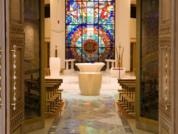Information Sheet 31
- Solid Masonry Construction
- Attic Conversions
- Keeping Project Costs Under Control
- Client Responsibilities under the new Building Control (Amendment) Regulations
- Harmful Substances in the Built Environment
- Extending Your Home – Exempted Development
- Guides to Liturgical Requirements
- Client Responsibilities under the Safety, Health and Welfare at Work (Construction) Regulations 2013
SOLID MASONRY CONSTRUCTION IN OLDER BUILDINGS:
Many older buildings, especially Churches, were constructed using a solid masonry form of construction. This form of construction generally consists of two leaves of relatively respectable stonework with a centre core of smaller stones bonded with a lime based mortar. The walls will also generally have a lime based render internally.
It is accepted that all solid masonry construction will absorb moisture and that rainwater will generally penetrate masonry construction up to a depth of 12 inches. However, the thickness of such walls is such that normal penetration very seldom reaches the inner lining. Any moisture, which does enter very quickly evaporates from the surface or out through the external surface of the wall aided by the drying effects of the wind and sun.
As this type of construction ages the lime mortars used in the original construction perish and it has been our experience to encounter cores of such construction in a damp puttylike and sandy state.
When there is a breakdown of pointing or a decay of the central core of a masonry wall there is little to impede the ingress of moisture and the core of the wall tends to absorb and encourage it. The moisture then filters through the decaying material working its way downwards through the wall and exiting where it finds weak points either working to the exterior through poor joints, or to the interior where internal indicators are the staining and perishing of internal rendered finishes. In the case of this building the internal evidence is unquestionable while, as stated above, most of the external joints weep.
If it were possible to solidify or consolidate the core of the wall there would be every chance of eliminating evidence of dampness in the future. However, this is not possible without reconstruction and the best we can hope for is to achieve a situation whereby the ingress of moisture is minimised by proper pointing of the stonework and proper weathering of all junctions. There is a careful balance to be struck between the strength of the pointing material and the inherent flexibility or movement of the building itself. In the event that the pointing material is too hard there may be a risk of fracturing stonework and if it is too soft it may tend to lose adhesion and become porous. Expert advice and craftsmanship is required in any repointing work.
Obviously, there is no guarantee that it will be possible to prevent the future ingress of moisture. However, having repaired the exterior of the building and carried out whatever internal repairs are deemed necessary, regular decoration and maintenance, proper and adequate heating of the building fabric during the cold periods of the year and proper and adequate ventilation will control internal conditions. If the internal fabric of the renovated building is kept warm during the winter period the detrimental effects of moisture ingress will be minimised.
©Holly Park Studio Ltd








